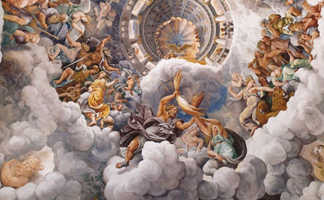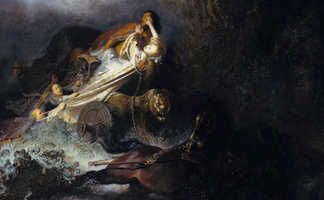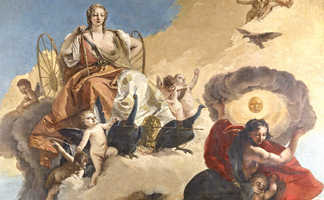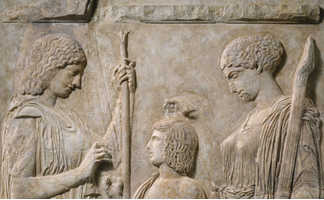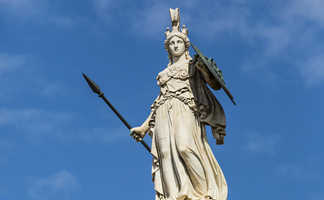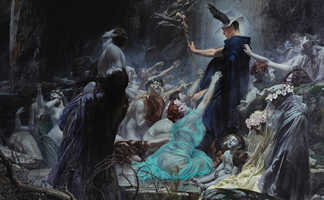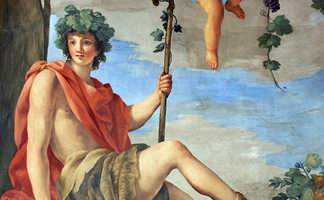Even today, “Artemis” is one of the most popular names for girls in Greece. There are reasons for this. For one thing, she is the patron of young girls. She’s also the patron of childbirth, childcare, and chastity. She is called by one ancient poet the “protectress of dewy youth.”
She is the goddess of the hunt, and is usually portrayed with a bow and arrow, and wearing a quiver over her shoulder.
She is also often depicted as carrying hunting spears, wearing a cap made of animal pelt, or a head band, with a deer skin cape. She is also often accompanied by a stag. The deer was her sacred animal.
Her foundational attribute is that she’s the virginal, chief goddess of nature and vegetation. In addition to killing game, she also protects animals.
The image of Artemis is of a vibrant, strong, independent woman in charge of wild nature, dancing in the glades with her entourage of nymphs, or hunting forest creatures. She was the most popular rural goddess in ancient Greece. One of three maiden deities of Olympus (Athena and Hestia are the other two), Artemis was chaste, and had no need of male companionship.
Like most of the Olympians, Artemis could be kind and tender, but also cruel and vengeful. Her wrath was correlated to the frequent hostile face wild nature shows to human beings. For example, a hunter, Aktaion, once spied Artemis bathing in a spring, and was transformed by her into a stag and torn apart by his own hounds for his transgression.
But it was also said that when women died a quick, painless and merciful death it was on account of her silver arrows. At any rate, her wrath was never portrayed in Greek art because depictions of her in sculpture were rare until the relatively peaceful 4th century, BC.
Artemis is identified with the moon, while her twin brother, Apollo, who also remained unmarried, is identified with the sun.
Their mother, Leto, was the daughter of the Titans Coeus and Phoebe. Leto caught Zeus’ eye, and he impregnated her with the twins. Leto is the only non-mortal to be punished by Hera for having relations with Zeus. She otherwise only targeted Zeus’ mortal lovers. In this case, Hera forbade Leto to give birth anywhere on dry land. So she headed off to Delos, which floated, unattached to the earth.
The story is that Artemis was born first, then she turned and helped deliver Leto of Apollo. This is not unusual among the Olympians; Hermes, if you remember, stole a herd of cattle when he was one day old.
Callimachus of Alexandria, 3rd century, BC poet, writes an extensive Hymn to Artemis, in which he describes her as a girl sitting on Zeus’ knee and requesting that she have authority over the woodlands, streams and lakes, and to “seldom go down to the town.” She says she will visit the cities only when “women vexed by the pain of childbirth call to me to be their aid,” just as she helped her own mother give birth to her brother, Apollo.
As Callimachus tells it, Artemis then heads off to the island of Lipari, off the north coast of Sicily, where three Cyclopes (Brontes, Steropes, and Argus) serve as assistants “at the anvils of Hephaestus,” fabricating a horse trough for Poseidon. (The forge of Hephaestus was said to be in nearby Mt. Aetna, the largest active volcano in Europe).
Artemis requests of the boys that they fashion bow, arrows and a metal quiver for her. Previous to that they had also made arrows for her brother, Apollo.
During the Trojan War, Artemis sided with the Trojans. Her brother, Apollo, was the patron of Troy. The Trojans worshipped her as well. While preparing to set sail, the Greek king Agamemnon offended Artemis by killing a sacred stag, and bragging that he was a better hunter than she. Artemis repaid this insult by becalming the waters of the Aegean, preventing the Greek fleet from sailing unless Agamemnon sacrificed his daughter Iphigenia. Unprincipled Agamemnon then deceives his daughter by saying that she will marry Achilles. Instead, his plan was to kill his innocent daughter. In most versions of the story, Artemis, protectress of women and girls, rescues Iphigenia at the last moment and replaces her with a deer, a story somewhat reminiscent of the Sacrifice of Isaac.
During the war, Artemis healed the Trojan hero Aeneus, who was portrayed in Virgil’s Aeneid as an ancestor of Romulus and Remus, and Rome’s first heroic personage. At one point Artemis confronted the more powerful Hera, who soundly thrashed her, taking her quiver and using her own arrows against her.
The great temple to Artemis at Ephesus was considered one of the Seven Wonders of the Ancient World. It was also the site of a dramatic episode in the New Testament book of Acts, when the Apostle Paul’s introduction of Christianity to the Ephesians created tensions with the sellers of manufactured idols of Artemis and triggered a massive public riot.
Wildlife considered sacred to Artemis include, as mentioned, deer, as well as the bear, freshwater fish, partridges, and the buzzard hawk. Plants associated with Artemis include the amaranth (a non-cereal grain cultivated for thousands of years), and the cypress and palm trees.


